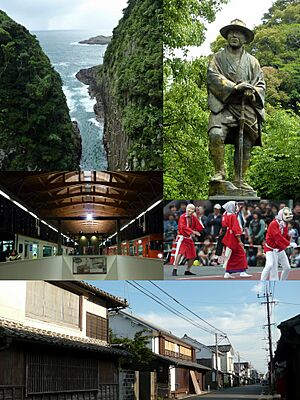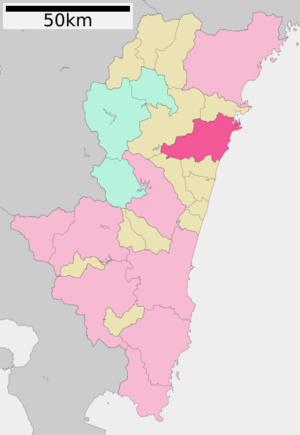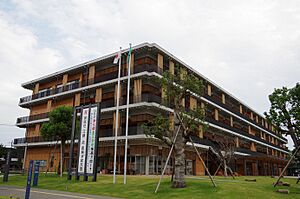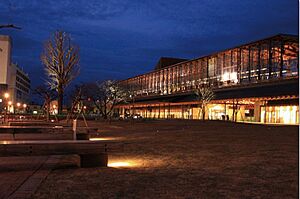Hyūga, Miyazaki facts for kids
Quick facts for kids
Hyūga
日向市
|
|||||||||||
|---|---|---|---|---|---|---|---|---|---|---|---|

Top left: Umagase in Nippo Coast Quasi National Park. Top right: Statue of Bokusui Wakayama in Tōgō. Middle left: View of platform at Hyugashi Station. Middle right: Hyottoko dancing event in August. Bottom: Old Traditional Town in Mimitsu.
|
|||||||||||
|
|||||||||||
 |
|||||||||||
| Country | Japan | ||||||||||
| Region | Kyushu | ||||||||||
| Prefecture | Miyazaki | ||||||||||
| Area | |||||||||||
| • Total | 336.94 km2 (130.09 sq mi) | ||||||||||
| Population
(October 1, 2023)
|
|||||||||||
| • Total | 57,746 | ||||||||||
| • Density | 171.384/km2 (443.882/sq mi) | ||||||||||
| Time zone | UTC+09:00 (JST) | ||||||||||
| City hall address | 10-5 Honmachi, Hyūga-shi, Miyazaki-ken 883-8555 | ||||||||||
| Climate | Cfa | ||||||||||
|
|||||||||||
Hyūga (日向市 (Hyūga-shi)) is a city located in Miyazaki Prefecture, Japan. As of October 1, 2023, about 57,746 people live there. This makes it the fourth largest city in Miyazaki Prefecture. The city covers an area of 336.94 square kilometers.
Hyūga is a port city. It is famous for making stones used in the board game Go. Many of its beaches are also popular spots for surfing.
Contents
- What Does the Name Hyūga Mean?
- Where is Hyūga Located?
- How Many People Live in Hyūga?
- What Are the Main Areas of Hyūga?
- A Look Back at Hyūga's History
- What is Hyūga's Economy Like?
- Schools in Hyūga
- Getting Around Hyūga
- Sister Cities
- Fun Things to Do in Hyūga
- Famous People from Hyūga
- Images for kids
- See also
What Does the Name Hyūga Mean?
Hyūga City gets its name from Hyūga Province (日向国 (Hyūga/Hinata no kuni)). This was the old name for what is now Miyazaki Prefecture. A Japanese legend says that Emperor Keikō once watched the sun rise over the ocean. He said, "This country faces straight toward the sunrise."
Because of this, the area became known as Hyuga or Hinata, meaning "the country facing the sun." This name was used until the Meiji Restoration, when it was changed to Miyazaki.
Where is Hyūga Located?
Hyūga is in the middle of Miyazaki Prefecture. To the east, it borders the Hyūga Sea. To the west, it is next to the Kyushu Mountains.
The coastline near Cape Hyūga is very unique. It has cool hexagonal pillar rocks and a jagged, saw-tooth shape called a ria coastline. This area is part of the Nippō Kaigan Quasi-National Park. South of this, you'll find beaches like Ise-ga-hama, Okura-ga-hama, and Kane-ga-hama, which are great for surfing.
Cities and Towns Near Hyūga
Hyūga shares its borders with several other places in Miyazaki Prefecture:
- Kadogawa is to the north.
- Kijō is to the southwest.
- Misato is to the west.
- Tsuno is to the south.
What is Hyūga's Climate Like?
Hyūga has a humid subtropical climate. This means it has four clear seasons. The weather is mild but humid, and there is no dry season. It's similar to the southern coastal areas of the United States or parts of southern Europe.
In summer, the average daytime temperature is around 30°C (86°F) with high humidity. In winter, the average daytime temperature is about 13°C (56°F) with less humidity. Early summer brings a rainy season in June and July. After that, it's hot and humid with lots of sunshine, but sometimes typhoons can occur. Winters are mild with little rain.
| Climate data for Hyūga (1991−2020 normals, extremes 1977−present) | |||||||||||||
|---|---|---|---|---|---|---|---|---|---|---|---|---|---|
| Month | Jan | Feb | Mar | Apr | May | Jun | Jul | Aug | Sep | Oct | Nov | Dec | Year |
| Record high °C (°F) | 23.4 (74.1) |
25.2 (77.4) |
29.1 (84.4) |
30.1 (86.2) |
32.9 (91.2) |
35.9 (96.6) |
37.6 (99.7) |
38.9 (102.0) |
35.7 (96.3) |
32.6 (90.7) |
29.2 (84.6) |
24.1 (75.4) |
38.9 (102.0) |
| Mean daily maximum °C (°F) | 13.0 (55.4) |
14.0 (57.2) |
17.0 (62.6) |
21.4 (70.5) |
24.8 (76.6) |
26.7 (80.1) |
30.9 (87.6) |
31.8 (89.2) |
29.1 (84.4) |
24.8 (76.6) |
19.9 (67.8) |
14.8 (58.6) |
22.4 (72.2) |
| Daily mean °C (°F) | 6.8 (44.2) |
7.9 (46.2) |
11.1 (52.0) |
15.6 (60.1) |
19.6 (67.3) |
22.5 (72.5) |
26.3 (79.3) |
27.0 (80.6) |
24.2 (75.6) |
19.2 (66.6) |
13.9 (57.0) |
8.7 (47.7) |
16.9 (62.4) |
| Mean daily minimum °C (°F) | 1.8 (35.2) |
2.7 (36.9) |
5.8 (42.4) |
10.5 (50.9) |
15.1 (59.2) |
19.2 (66.6) |
22.9 (73.2) |
23.7 (74.7) |
20.7 (69.3) |
15.0 (59.0) |
9.4 (48.9) |
3.8 (38.8) |
12.6 (54.6) |
| Record low °C (°F) | −6.0 (21.2) |
−7.1 (19.2) |
−3.3 (26.1) |
0.5 (32.9) |
6.5 (43.7) |
10.8 (51.4) |
15.4 (59.7) |
16.0 (60.8) |
9.4 (48.9) |
4.2 (39.6) |
−0.9 (30.4) |
−5.5 (22.1) |
−7.1 (19.2) |
| Average precipitation mm (inches) | 68.0 (2.68) |
96.1 (3.78) |
156.9 (6.18) |
205.3 (8.08) |
270.0 (10.63) |
474.3 (18.67) |
281.5 (11.08) |
272.7 (10.74) |
391.7 (15.42) |
226.7 (8.93) |
114.0 (4.49) |
74.4 (2.93) |
2,633.3 (103.67) |
| Average precipitation days (≥ 1.0 mm) | 5.5 | 7.2 | 9.9 | 10.0 | 10.8 | 15.5 | 11.7 | 12.6 | 12.6 | 8.5 | 7.2 | 5.3 | 116.8 |
| Mean monthly sunshine hours | 196.8 | 181.1 | 186.5 | 193.8 | 183.9 | 121.7 | 193.8 | 203.2 | 159.0 | 177.9 | 173.1 | 188.2 | 2,162.4 |
| Source: Japan Meteorological Agency | |||||||||||||
How Many People Live in Hyūga?
As of November 2015, Hyūga had a total population of 63,011 people. This included 30,150 males and 32,861 females.
| Population of Hyūga | ||||||||||||||||||||||||||||||||||||||||||||||||||||||||||||||||||||||||||||||||||||||
|---|---|---|---|---|---|---|---|---|---|---|---|---|---|---|---|---|---|---|---|---|---|---|---|---|---|---|---|---|---|---|---|---|---|---|---|---|---|---|---|---|---|---|---|---|---|---|---|---|---|---|---|---|---|---|---|---|---|---|---|---|---|---|---|---|---|---|---|---|---|---|---|---|---|---|---|---|---|---|---|---|---|---|---|---|---|---|
|
|
|
||||||||||||||||||||||||||||||||||||||||||||||||||||||||||||||||||||||||||||||||||||
| In 2006, Togo was merged into the city, adding about 1,750 people to the population. This accounts for part of the increase in that year. | ||||||||||||||||||||||||||||||||||||||||||||||||||||||||||||||||||||||||||||||||||||||
What Are the Main Areas of Hyūga?
Hyūga is made up of several unique districts:
Shinmachi: The Modern Downtown
Shinmachi (新町地区, Shinmachi-chiku) is the downtown area of Hyūga. The city has been working to make it more modern. They are widening roads, adding new businesses, and making the area more beautiful. Because of this, Shinmachi looks quite new and modern. This area is built around Hyūgashi Station.
Hososhima: Port Life and Industry
Hososhima (細島地区, Hososhima-chiku) has two main parts. The southern part is where Hyūga's commercial fishing port is located. This area is older and has narrow streets with many buildings from the Edo period.
The northern part of Hososhima is more industrial. It has several factories and large areas for storing goods. Hososhima Industrial Port is the main international port for northern Miyazaki Prefecture. It handles imports and exports for the region. The Japanese government chose it as a "focus port" in 2010 and "Port of the Year" in 2015. There are ongoing plans to expand the port.
Mimitsu: A Historic Port Town
Mimitsu area (美々津地区, Mimitsu-chiku) was a port town south of Hyūga that joined the city in 1955. It is known for its traditional washi paper and fishing. Legend says that the first Japanese Emperor, Jimmu, started his journey to conquer Yamato from this port.
In the 1800s, Mimitsu was a busy trading port. It was a center for trade with big cities like Kyoto, Osaka, and Kobe. So many merchant houses were there that people called it "the thousand houses of Mimitsu." However, when railroads became popular, the town's importance declined. In 1986, it was recognized as an important historical area. Today, much of its 19th-century feel remains, with old buildings, earthen walls, and stone pavements.
Togo: Home of a Famous Poet
Togo (東郷地区, Togo-chiku) was a small mountain town that became part of Hyūga on February 25, 2006. Togo is famous as the hometown of the Japanese writer Bokusui Wakayama.
A Look Back at Hyūga's History
Archaeologists have found tools and other items in Hyūga that are up to 30,000 years old. This shows that people lived here during the Japanese Paleolithic period. There is also proof of people living here during the Jōmon period, with pottery from that time still being found today.
During the Edo period, Hyūga was split between two different rulers. After the Meiji restoration, modern towns and villages were created. The town of Hososhima and the villages of Iwawaki and Tomidaka were formed on May 1, 1889. Tomidaka became a town on October 1, 1921. Then, on October 1, 1937, Hososhima and Tomidaka joined to become Toshima Town. Finally, Toshima merged with Iwawaki to form the city of Hyūga on April 1, 1951.
How Hyūga City Grew Over Time
Modern Hyūga City was formed by many smaller towns and villages joining together. These mergers started when Japan changed its old ruling system. Towns continued to merge, often because they had too few people or not enough money. The most recent merger was in 2006 with Tōgō. This was part of a government plan to help cities with shrinking populations and money problems. This merger helped Hyūga City grow its population, tax income, and independence.
What is Hyūga's Economy Like?
Hyūga is an important industrial center. It has many chemical plants that belong to the Asahi Kasei group. Other big industries in Hyūga include metal processing and making titanium. Food processing is also a key part of the economy.
Schools in Hyūga
Hyūga has a good number of schools for its young people. There are 13 elementary schools, seven junior high schools, and three high schools. There is also a special education school for students with disabilities.
High Schools
- Hyūga High School
- Tomishima High School
- Hyūga Industrial High School
Junior High Schools
- Iwawaki Junior High School
- Zaikōji Junior High School
- Daiodani Academy – Junior High School
- Hyūga Junior High School
- Mimitsu Junior High School
- Tomishima Junior High School
- Tōgō Junior High School
Elementary Schools
- Shiomi Elementary School
- Saiwaki Elementary School
- Hososhima Elementary School
- Zaikōji Elementary School
- Zaikōji Minami Elementary School
- Daiodani Academy - Elementary School
- Hichiya Elementary School
- Hichiya Higashi Elementary School
- Mimitsu Elementary School
- Tomitaka Elementary School
- Hiraiwa Elementary School
- Tōgō Elementary School
- Tsuboya Elementary School
Getting Around Hyūga
Railways
You can travel by train in Hyūga using the JR Kyushu Nippō Main Line. The stations in Hyūga are:
- Hyūgashi
- Zaikōji
- Minami-Hyūga
- Mimitsu
Highways
Major roads that pass through or near Hyūga include:
 Higashikyushu Expressway
Higashikyushu Expressway National Route 10
National Route 10 National Route 327
National Route 327 National Route 446
National Route 446 National Route 503
National Route 503
Sister Cities
Hyūga has a special friendship with one city:
Fun Things to Do in Hyūga
Annual Cultural Events
- Hyottoko Summer Festival (ひょっとこ夏祭り (hyottoko natsu matsuri)): This festival happens on the first Friday and Saturday of August each year. It's the biggest festival in Hyūga City, drawing visitors from all over Japan. The unique Hyottoko dance is a symbol of the city.
- Hyuga Jugoya Festival (日向十五夜祭 (hyuga jugoya matsuri)): This festival takes place in September or October, around the time of the harvest moon. In Hyūga City, it features two traditional dances, including one specific to the Togo region. It's the second largest festival in the city.
Museums and Other Interesting Places
- Hyuga Historical and Folk Museum (日向市歴史民俗資料館 (Hyūgashi rekishi minzoku shiryōkan)): Learn about the history and culture of Hyūga.
- Bokusui Wakayama Memorial Museum of Literature (若山牧水記念文学館 (Wakayama bokusui kinen bungaku-kan)): A museum dedicated to the famous poet Bokusui Wakayama.
- Hososhima Port Museum (細島みなと資料館旧高鍋屋 (Hososhima Minato shiryōkan kyū Takanabe-ya)): Discover the history of Hososhima Port.
Famous People from Hyūga
- Norichika Aoki: A professional baseball player who played in Major League Baseball.
- Masatora Kawano: A Japanese athlete known for racewalking.
- Bokusui Wakayama: A well-known Japanese poet.
Images for kids
See also
 In Spanish: Hyūga (Miyazaki) para niños
In Spanish: Hyūga (Miyazaki) para niños










